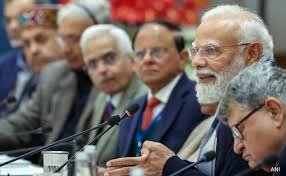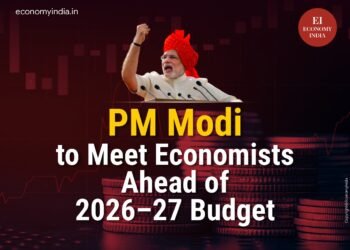The National Statistical Office (NSO) will release GDP numbers for the quarter ending March 2022 at the end of this month. On June 8, the Monetary Policy Committee (MPC) of RBI will publish its resolution which will have GDP growth forecasts for 2022-23. Most analysts expect a downward revision in 2022-23 growth forecasts and perhaps also a lower than expected growth performance in the March 2022 quarter which could bring down growth for the fiscal year 2021-22.
While there will be greater clarity on these once these numbers are released, the Indian economy’s medium term economic challenge goes beyond headline growth numbers. Here are three charts which explain this in detail.
The crisis in employment intensive sectors seems to have become a systemic problem
This is best seen from a long-term comparison of growth by sectors in Gross Value Added (GVA). A comparison of decadal compound annual growth rate (CAGR) of major sub-sectors from 1981-82 onwards shows that the last decade (2011-12 to 2021-22) was the second worst in terms overall GVA growth. To be sure, this performance needs to be read in the context of the pandemic’s shock to economic activity which basically wiped out a year of growth (and hence dragged down the decadal CAGR).
However, a comparison of GVA numbers by sectors shows that employment intensive non-farm sectors have performed even worse in the last decade. For example, the GVA of the construction sector had a CAGR of 3.1% between 2011-12 and 2021-22, significantly lower than 10.3% value between 2001-02 and 2011-12 and even lower than the previous all-time low of 4.2% between 1981-82 and 1991-92 period.
Similarly, trade, hotels, transport, communication and broadcasting services, another labour intensive non-farm sector, also saw its lowest GVA growth during the period from 2011-12 to 2021-22. As per the 2018-19 Periodic Labour Force Survey (PLFS) the employment share of the construction and trade, hotel, transport, communication and broadcasting services categories was 12.1% and 18.5% respectively.
Terms of trade have likely worsened significantly for farmers
The current high inflation phase, including in food items has generated an impression that farmers are seeing tailwinds boost their incomes. However, a closer look at inflation data shows that this is unlikely to be the case. Net incomes for any stakeholder in the economy depends on the ratio of prices received and paid.
This is also described by economists as terms of trade. While it is true that prices of key crops such as wheat and other food items has risen in the recent period, what it also true is that prices of inputs and other commodities has been increasing at an even higher pace. This is likely to have worsened the ratio of prices of receivables and payables for farmers.
While exact terms of trade statistics are available in India with a lag – they are published by the ministry of agriculture – a simple comparison of wholesale inflation for food articles component of primary products sub-category and everything else in the Wholesale Price Index (WPI) basket shows that the latter has been growing at a higher rate than the former in the recent past.
WPI is a better measure of farmers’ incomes because they mostly sell their product to traders in the wholesale market. The worsening in terms of trade is bound to put a squeeze on farm incomes.
Because global food prices are likely to stay at elevated levels in the near future and the Indian economy is facing widespread inflationary pressure, the government is likely to hold back on providing price support or even allowing the benefit of market-driven income tailwinds to farmers.
Stock market indices hide the extent of correction
The discussion so far suggests that economic prospects for the blue-collar section of the Indian economy are likely to remain muted. While some economists have been warning about such a possibility and the increase in inequality and the headwinds to growth it will bring, another set of economists has been arguing that this need not dampen the growth potential of the Indian economy which has always been skewed in favour of the formal sector.
The divergence between the performance of the formal and informal sector of the Indian economy is one of the biggest reasons why India’s stock markets managed to buck the trend of overall slowdown in growth.
To be sure, India’s stock market rally was also helped by favourable international factors such as low interest rates in developed countries, which sent foreign capital to emerging market economies such as India in search of better returns.
The glut of hot finance in stock markets added to the future premium, which is best seen in a sharp-rise in Price-Earnings or PE multiple in India. With monetary tightening on the cards in both advanced and emerging market economies these tailwinds are expected to dissipate.
A look at the long-term performance of the BSE S&P Index shows that the headline index number actually hides the extent of correction in the stock market. The correction in the PE multiple in the recent past has been far bigger than that in the overall value of the index. To be sure, one reason why the BSE Index hides the extent of correction is also the sharp increase in inflation which has boosted nominal share prices.
Given the fact that advanced countries, especially the US, are unlikely to roll back their ongoing monetary tightening, stock markets in India are unlikely to enjoy the bull run they enjoyed in the recent past. While this is not necessarily a bad thing for the economy, it will take some time for both companies and retail investors to get used to the fact. (Source: Hindustan Times)















